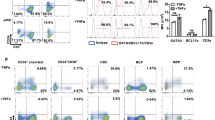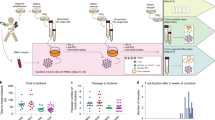Abstract
CYTOTOXIC T lymphocytes (CTLs), capable of lysing autologous and HLA-identical human leukaemia cells, can be generated in vitro by culturing lymphocytes from patients in remission from leukaemia with X-ray irradiated autologous leukaemia cells and irradiated allogeneic normal cells in ‘three-cell’ mixed leukocyte culture (MLC) protocols1–3. Additionally, T cells cultured with X-ray irradiated normal lymphocytes pooled from 20 unrelated individuals can differentiate into CTLs capable of lysing autologous Epstein-Barr (EB) virus-transformed lymphoblastoid cell lines and autologous human leukaemia cells, but not autologous normal cells4,5. Because in vitro generated CTLs directed against syngeneic tumour cells can inhibit tumour development in some animal tumour systems6–9, it is likely that if large numbers of human CTLs cytotoxic for autologous malignant cells could be generated in vitro, these CTLs could be effective in eliminating residual malignant cells in patients who have received chemotherapy. Recent findings that normal human T cells10,11 and allosensitised mouse12 and human CTLs13,14 grow continuously in medium containing T-cell growth factor (TCGF) derived from super-natants of mitogen-stimulated lymphocytes, have raised the possibility that large numbers of in vitro generated CTLs cytotoxic for autologous human malignant cells could be propagated by growing CTLs in TCGF. We report here that in vitro generated CTLs cytotoxic for autologous lymphoblastoid cell lines (LCL) and human leukaemia cells can be increased in number by several millionfold by growth in TCGF and that the continuously growing CTLs are highly cytotoxic for autologous abnormal cells.
This is a preview of subscription content, access via your institution
Access options
Subscribe to this journal
Receive 51 print issues and online access
$199.00 per year
only $3.90 per issue
Buy this article
- Purchase on Springer Link
- Instant access to full article PDF
Prices may be subject to local taxes which are calculated during checkout
Similar content being viewed by others
References
Zarling, J. M., Raich, P. C., McKeough, M. & Bach, F. H. Nature 262, 691–693 (1976).
Lee, S. K. & Oliver, R. T. D. J. exp. Med. 147, 912–922 (1978).
Sondel, P. M., O'Brien, C., Porter, L., Schlossman, S. F. & Chess, L. J. Immun. 117, 2197–2203 (1976).
Zarling, J. M. & Bach, F. H. J. exp. Med. 147, 1334–1340 (1978).
Zarling, J. M., Robins, H. I., Raich, P. C., Bach, F. H. & Bach, M. L. Nature 274, 269–271 (1978).
Rollinghoff, M. & Wagner, J. J. natn. Cancer Inst. 51, 1317–1318 (1973).
Treves, S. J., Cohen, I. R. & Feldman, M. J. natn. Cancer Inst. 54, 777–780 (1975).
Bernstein, I. D. J. Immun. 118, 122–127 (1977).
Cheever, M. A., Kempf, R. A. & Fefer, A. J. Immun. 119, 714–718 (1977).
Morgan, D. A., Ruscetti, F. W. & Gallo, R. C. Science 193, 1007–1008 (1976).
Bonnard, G. D. et al. in Human Lymphocyte Differentiation. Its Application to Human Cancer (ed. Serrou, B) (North-Holland, Amsterdam, in the press).
Gillis, S. & Smith, K. A. Nature 268, 154–156 (1977).
Gillis, S., Baker, P. E., Ruscetti, F. W. & Smith, K. A. J. exp. Med. 148, 1093–1098 (1978).
Strausser, J. L. & Rosenberg, S. A. J. Immun. 121, 1491–1495 (1978).
Gillis, S., Ferm, M. M., Ou, W. & Smith, K. A. J. Immun. 120, 2027–2032 (1978).
Bentwich, Z., Douglas, S. D., Skutelsky, E. & Kunkel, H. G. J. exp. Med. 137, 1532–1537 (1973).
West, W. H., Cannon, G. B., Kay, H. D., Bonnard, G. D. & Herberman, R. B. J. Immun. 118, 355–361 (1977).
Zarling, J. M., Eskra, L., Borden, E., Horoszewicz, J. & Carter, W. J. Immunology (in the press).
Ortaldo, J. R., Bonnard, G. D. & Herberman, R. B. J. Immun. 119, 1351–1357 (1977).
Herberman, R. B., Ortaldo, J. & Bonnard, G. D. Nature 277, 221–223 (1979).
Smith, K. A., Gillis, S. & Baker, P. E. Proc. Am. Ass. Cancer Res. 20, 93 (1979).
Author information
Authors and Affiliations
Rights and permissions
About this article
Cite this article
ZARLING, J., BACH, F. Continuous culture of T cells cytotoxic for autologous human leukaemia cells. Nature 280, 685–688 (1979). https://doi.org/10.1038/280685a0
Received:
Accepted:
Issue Date:
DOI: https://doi.org/10.1038/280685a0
This article is cited by
-
Recombinant interleukin-2 and lymphokine-activated killer cells in renal cancer patients: I. phenotypic and functional analysis of the peripheral blood mononuclear cells
Cancer Immunology Immunotherapy (1990)
-
Treatment of established tumor by adoptive immunotherapy with specifically immune T cells
Survey of Immunologic Research (1985)
-
Therapeutic use of interleukins: Experimental results
Survey of Immunologic Research (1984)
Comments
By submitting a comment you agree to abide by our Terms and Community Guidelines. If you find something abusive or that does not comply with our terms or guidelines please flag it as inappropriate.



